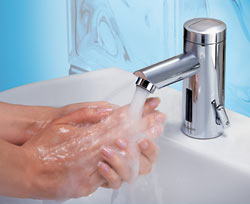Factors For Achieving Water Conservation Excellence:
Learning Objectives:
- Understand the architect's role in water conservation.
- Recognize what is required to earn points for LEED-NC Water Efficiency Credit 3.
- Understand how to calculate Baseline and Design Case indoor water consumption.
Credits:
Plumbing is one of those areas that architects rarely touched upon except in terms of design influence. Either relegated to the interior designer or engineer for the system specifications, plumbing as a "category" rarely crossed the architect's thought process as a major factor of design importance-until now.
What has changed dramatically is the growing awareness of water itself as a most precious resource, and the one resource most taken for granted. As we collectively grow in our awareness of water's scarcity, the architect finds issues of water as not only part of his decision-making process; his role as "master builder" thrusts him into the center of the efforts to save this resource. Thus, more than in the past, architects must not only familiarize themselves with an increasing variety of issues outside the scope of a building's structure; they must further tackle water's issues and water's relationship to sustainable design.
This article deals with the water resource, water conservation, and the factors that influence an architect's design strategies such as hands-free hygienic plumbing. It will familiarize the architect with the growing possibilities which exist today to conserve this resource, how to gain LEED® points, and how to use LEED calculations to achieve Water Use Reduction requirements. In addition, it will help the architect gain an understanding of the benefits extended to the sustainable design when water conservation is practiced.
|
Why the Focus on Water?
While traditionally much attention has been focused on controlling or conserving energy costs, controlling water costs has now become an objective due to growing population and limited fresh water supplies to meet the demand. For example, in the Southwest and the Pacific Northwest, freshwater sources are rapidly diminishing, spawning innovative methods of water conservation and improved management of the natural water-cycle. According to the U.S. Department of Energy, rising water and sewage costs average approximately $4.00 per 1,000 gallons across the United States-a pace expected to be two percent greater than inflation.
From the architect's point of view, these trends impact the entire "green design phenomenon," and ultimately, the design of structures themselves. When the point of view of preserving our most precious resource is folded into other design considerations, it becomes imperative to know where water is being consumed in different types of buildings. In other words, to create an effective plan that addresses water conservation, the architect's role spills over into water management issues as well as structural issues.










